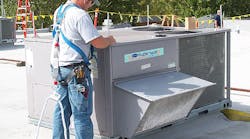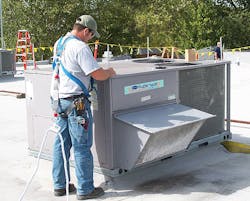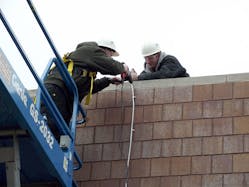Historically, electrical contractors have installed lightning protection systems. Over the years, however, specialty trades became popular — especially when workloads became heavy. In those cases, it made sense to outsource some types of work, such as telephone, fire alarm, and security. Lightning protection installation work also fell into this category. But in the last few years, the trend is for the electrical contractor community to once again become proficient in this work, bringing it back in-house. In fact, many large electrical contractors are now self-performing low-voltage and lightning protection projects.
Why should an electrical contractor install lightning protection systems? Let’s review some of the benefits of doing this type work with your own crews.
Take control of the project
Although many areas of the country still have reliable lightning protection subcontractors, many do not. Because lightning protection contractors are seldom on-site, it can be a scheduling dilemma to get them when needed. Factors contributing to this issue are high gas prices as well as other overhead items.
It’s becoming increasingly difficult for the lightning protection subcontractor to be profitable on smaller projects, especially if travel is required. Currently, many lightning protection contractors are no longer quoting small- to medium-sized projects, particularly when travel is involved. Therefore, if the electrical contractor is being forced to self-perform the smaller projects, why not do the same on the larger ones?
Another issue affecting the electrical contractor is progress payments, which are often held up due to the lightning protection contractor not showing up on a timely basis, thus not keeping up with the project’s percentage of completion targets. Often, even when using the services of a lightning protection subcontractor, the electrical contractor is already installing the lightning protection grounds and the lightning down conductors, which is two-thirds of the system. Why not just install the rest of the materials?
Increase your revenue
The historical markup for lightning protection systems is 30%. In some areas of the country, this number is even higher. This revenue could be realized by the electrical contractor while still providing a better price to the building owner.
Keep your own workers employed
In today’s tough economy, it makes more sense to keep your own people working. Why sub out work to others while your loyal employees are being laid off?
New source of revenue
Many electrical contractors, especially those providing service and maintenance work, are realizing a vast new income stream by offering audits on their customer’s existing lightning protection system. The audit usually results in updating the lightning protection system. Traditionally, this service hasn’t been offered by the lightning protection subcontractor because the payoff isn’t there for them. Prime candidates for this type of work include pharmaceutical and chemical plants, hospitals, and universities. Virtually any facility that operates in a campus-type environment is a new potential customer.
Create company value
Offering more services gives a company a competitive edge and provides more value to the customer. Being able to offer more pieces of the construction pie simplifies the construction process.
Debunking the myths
What are the reasons not to self-perform lightning protection? There are three main myths that seem to surface when discussing this type of work with electrical contractors.
Myth No. 1 — I’m not certified. Many lightning protection subcontractors, especially those in fear of losing the work, will tell the electrical contractor that one must be certified to install lightning protection systems. This statement is misleading and simply not true. The project is certified, and the materials and installation companies are listed. Becoming listed or partnering with a listed company is a simple process.
Myth No. 2 — I can’t find proper training. Some contractors believe there is limited formal training available in this area, but training centers exist across the country that offer courses on lightning protection systems. For example, the NJATC provides training in this area for the apprentice and the journeyman. Manufacturers of lightning protection equipment also offer training on the installation of their equipment and systems.
Myth No. 3 — I’m not insured to perform this type of work. You don’t need additional or special insurance to install lightning protection systems. This has been another source of misinformation in the industry.
Today’s tough economy calls for innovative changes. A well-trained workforce, skilled in all facets of electrical work, gives you a competitive advantage. Understanding the benefits of self-performing lightning protection systems work helps the electrical contractor gain another resource to provide value and round out the electrical package offering.
Harger is president/owner of Harger Lightning & Grounding, Grayslake, Ill. He can be reached at [email protected]. Riesberg is director of curriculum development for the NJATC in Upper Marlboro, Md. He can be reached at [email protected].





